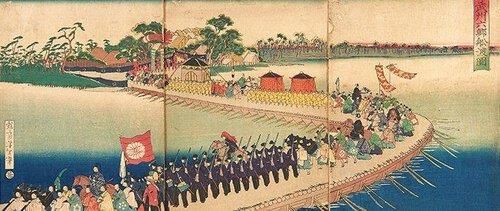|
What were the three important changes in Japan during the 16th century that influenced future development? |
Card: 1 / 50 |
|
Peasantry was disarmed to end war, autonomy was given to daimyo, and land surveys were conducted to ensure productivity and revenue.  |
Card: 2 / 50 |
|
Fill in the blank: The Meiji Restoration in Japan began with the removal of the ___ from power in 1868. |
Card: 3 / 50 |
|
True or False: The Japanese government adopted a policy of 'rich country, strong army' to promote agricultural development. |
Card: 5 / 50 |
|
False. The slogan was aimed at creating a sense of nationhood and transforming subjects into citizens. |
Card: 6 / 50 |
|
What was the primary focus of the educational reforms introduced in Japan during the Meiji period? |
Card: 7 / 50 |
|
To implement a universal and compulsory education system for boys and girls, emphasizing Japanese history while incorporating western ideas. |
Card: 8 / 50 |
|
Fill in the blank: The Great Proletarian Cultural Revolution began in ___ and aimed to eliminate old customs and habits. |
Card: 9 / 50 |
|
Ecological and socio-economic crises, including soil exhaustion, deforestation, and exploitative land tenure systems. |
Card: 12 / 50 |
|
True or False: After World War II, Japan was allowed to maintain a strong military as part of its new constitution. |
Card: 13 / 50 |
|
False. Article 9 of the constitution renounced war as a means of state policy. |
Card: 14 / 50 |
|
Fill in the blank: The number of industrial workers in Japan increased from ___ in 1870 to 4 million in 1913. |
Card: 15 / 50 |
|
What significant change did the Meiji government implement regarding military service? |
Card: 17 / 50 |
|
All young men over twenty were required to undergo a period of military service. |
Card: 18 / 50 |
|
What was the primary purpose of the Long March undertaken by the Communist Party of China? |
Card: 19 / 50 |
|
To seek a new base and develop programs for ending warlordism, land reforms, and fighting imperialism.  |
Card: 20 / 50 |
|
Fill in the blank: The establishment of the People's Republic of China in ___ was based on the principles of New Democracy. |
Card: 21 / 50 |
|
The modernization of the economy involved raising funds through agricultural taxes, developing infrastructure like railways, and establishing modern banking institutions.  |
Card: 24 / 50 |
|
Multiple Choice: Who was the major leader of the Communist Party of China during its rise? |
Card: 25 / 50 |
 Unlock all Flashcards with EduRev Infinity Plan Starting from @ ₹99 only
|
|
True or False: The Meiji Constitution created a parliament called the Diet with full legislative powers. |
Card: 27 / 50 |
|
What was one of the main criticisms of the Guomintang party under Chiang Kai-shek? |
Card: 29 / 50 |
|
It imposed military order rather than addressing the problems of the peasantry.  |
Card: 30 / 50 |
|
Fill in the blank: In Japan, the population increased from 35 million in 1872 to ___ million by 1920. |
Card: 31 / 50 |
|
What event marked the re-emergence of Japan as a global economic power in 1964? |
Card: 35 / 50 |
|
Fill in the blank: The first railway line in Japan was constructed between Tokyo and ___ during 1870-72. |
Card: 37 / 50 |
|
What was the role of the Red Guards during the Great Proletarian Cultural Revolution? |
Card: 39 / 50 |
|
They were used to attack old culture, customs, and habits as part of Mao's ideological campaign. |
Card: 40 / 50 |
|
True or False: The CCP's strategy during its rise was primarily focused on urban workers rather than peasants. |
Card: 41 / 50 |
|
To ensure each administrative unit had sufficient revenue to maintain local schools and health facilities. |
Card: 44 / 50 |
|
Fill in the blank: The concept of 'Overcoming Modernity' discussed in 1943 was about how to combat the ___ while being modern. |
Card: 45 / 50 |
|
The Meiji Restoration in Japan began significantly with the arrival of which American figure, who demanded trade and diplomatic relations? |
Card: 47 / 50 |
|
True or False: The Great Leap Forward aimed to rapidly industrialize China by encouraging individual private enterprises. |
Card: 49 / 50 |
|
False. The Great Leap Forward aimed to galvanize the country to industrialize rapidly through collective efforts and government control.  |
Card: 50 / 50 |




























